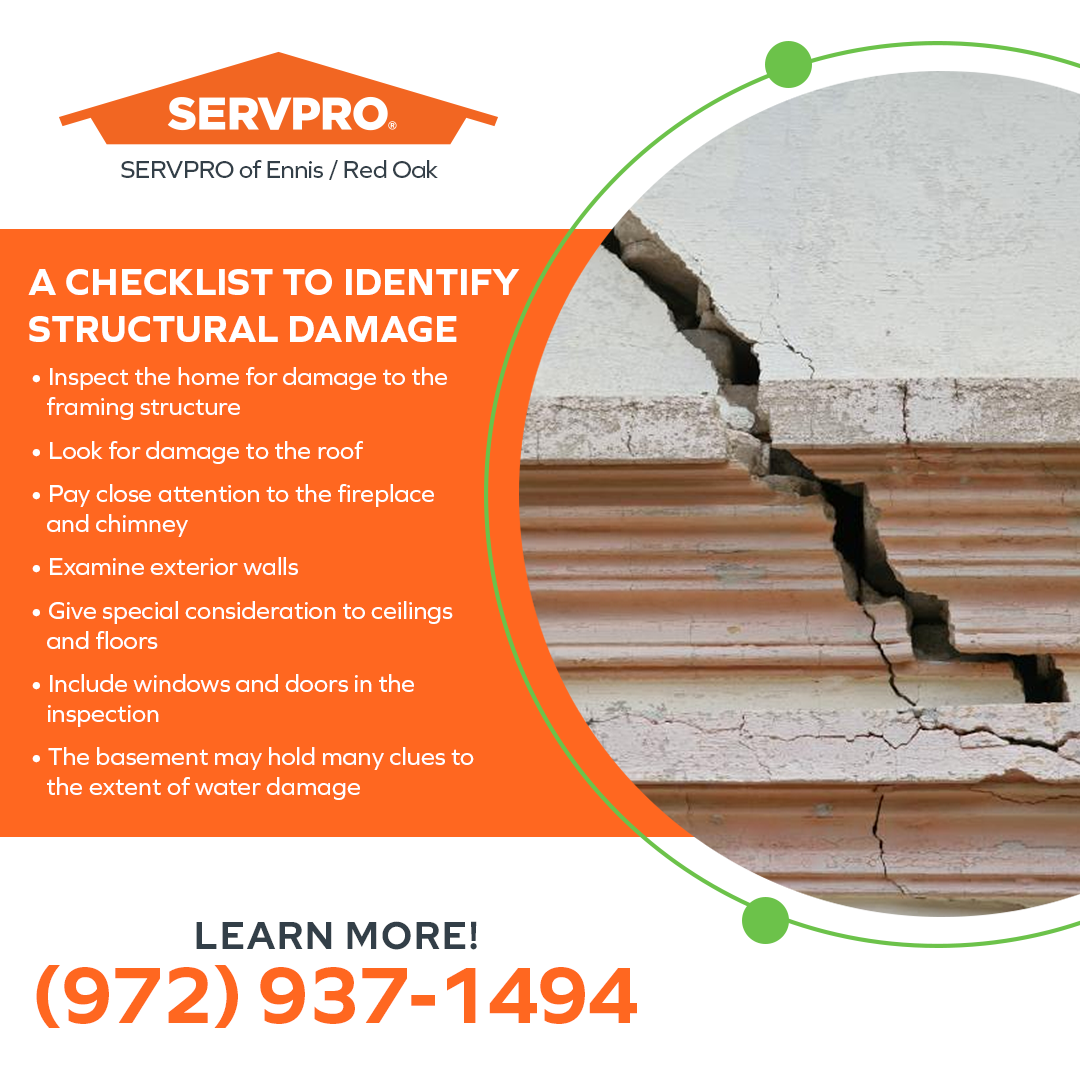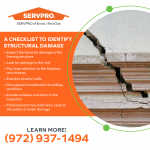SERVPRO® of Ennis/Red Oak is available 24/7 to provide flood restoration services when disaster strikes. Flooding can devastate a home. Too often, some aspects of the damage escape attention until much later. A thorough inspection of the structure to identify the extent of the damage needs to be conducted in the aftermath of the flooding. Damage usually occurs to either the foundation, the structure resting on the foundation or both.

Homeowners and prospective buyers should familiarize themselves with the dynamic forces causing the damage. This information will ensure the scope of the inspection will identify flood damage. Flood water moving at a speed of 10 miles per hour can exert the same pressure as a gust of wind blowing at 270 miles per hour. The effects of this dynamic force can cause serious structural damage to a home or other structures.
A checklist to identify structural damage
#1. Inspect the home for damage to the framing structure.
When a house has encountered flood waters, support beams and framing timbers may be affected. The structural integrity may be compromised. The inspection begins by observing the structure from a distance of about 50 to 100 feet. Visually inspect all four sides of the home. The structure may be fully intact. However, the flood waters may have altered the soundness of the structure, thus weakening its overall strength. Consider the following important questions:
- Does the house appear to be out of kilter? Is it leaning or tilting to the degree it is noticeable?
- Have large sections of the structure been ripped away or broken?
- Does the home appear to be squarely positioned on the foundation?
- Has the house partially shifted off its foundation?
Large-scale misalignments signal trouble with the integrity and strength of the building affected by flood waters.
#2. Look for damage to the roof.
Visible signs of sagging or bowing on the roof are warning signs of a lack of structural integrity in the support beams in the attic or of warping of roof sheathing from exposure to moisture. If the roof has undulations or waves, all is not well under the shingles. Look for new lumps on the roof. Step far away enough from the home to be able to see if any portions of the roofing are missing or rolled up like a rug. Are shingles, pieces of plywood, or strips of underlayment strewn across the yard in hanging bushes and shrubs? When a home has been exposed to the dynamic forces of a flood, rafters and trusses in the attic can crack, splinter, or break. If flood waters were intense, venturing into the attic could be dangerous.
#3. Pay close attention to the fireplace and chimney.
- If the fireplace or chimney leans or has a bow, structural damage may be the cause.
- Look for gaps where the chimney has separated from the side of the house.
- Pay special attention to any cracked bricks, broken stones, or loose material.
- Inspect the base of the chimney for a concentration of displaced mortar, shards of brick, or unexplained rocks or stones.
#4. Examine exterior walls.
Exterior walls tell a story. Warping, bowing, cracks, and ripples in the walls indicate stress from a flood dynamic. Corners should be vertical and straight. Is the wall attached to the roof? Is the wall seated securely on the foundation?
#5. Give special consideration to ceilings and floors.
- If the floors or ceilings sag or droop, it does not bode well for the home.
- Soft, spongy floors underfoot indicate water damage.
- Warping, sloping, or bowing that is new is a sign of flood damage.
#6. Include windows and doors in the inspection.
Look closely for gaps in the doors and windows. Windows and doors that stick or fail to open or close hint at structural damage from flooding or excess water. Test self-opening doors and windows for functionality. Scraping or dragging indicates a problem.
#7. The basement may hold many clues to the extent of water damage.
Be sure to use a flashlight when inspecting the basement. The lighting may be inadequate, resulting in shadows and glare, which makes spotting evidence of damage very difficult.
Look for:
- Cracks, bows, or waves in the walls
- Concave or convex shapes in the basement walls
- Bowing, cracking or twisting of any beam or posts that are providing support to the floor above
This checklist will help homeowners identify structural damage from floodwater. When disaster strikes, turn to the professionals at SERVPRO® of Ennis/Red Oak for assistance. Certified technicians bring state-of-the-art equipment and cleaning techniques to every challenging situation.

For more information about flooding and water damage restoration services, residential and commercial property damage cleanup and restoration services in Corsicana, TX, contact the SERVPRO of Ennis/Red Oak office by phone at (972) 937-1494 or by email at acarey@servpro10932.com.
































